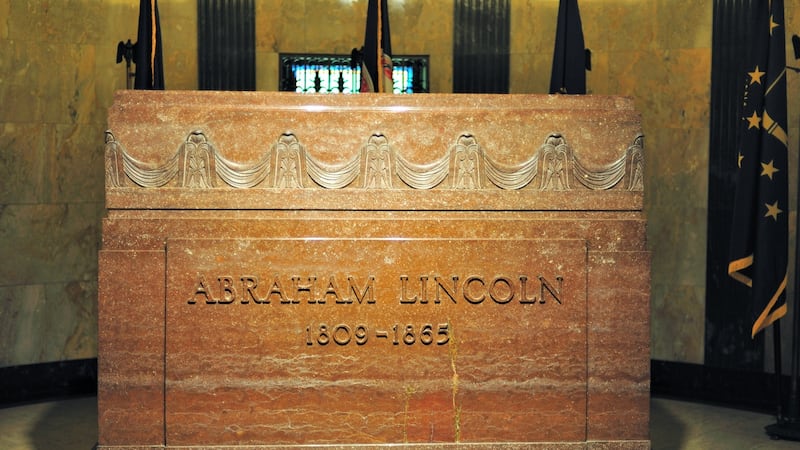In 1658, the writer Thomas Browne asked: “But who knows the fate of his bones, or how often he is to be buried?” His words proved prophetic: about two centuries later, a sexton exhumed Browne’s skull from its Norfolk churchyard, and his head was later put on display in a hospital museum. It wasn’t reburied until 1922, when its age was recorded in church ledgers as “317 years”.
Many other famous lives have had surprising postscripts: famous corpses have been bought and sold, studied, collected, stolen, and dissected. They’ve been used to found churches, cities, and even empires (in the case of Alexander the Great). Pieces of them have languished in libraries and museums, in coolers and filing cabinets, and in suitcases underneath beds. As a species, it seems we are truly incapable of letting our famous dead rest in peace.
Below, a selection from some of the most surprising such tales.


Abraham Lincoln
Abraham Lincoln was the first American president to be embalmed, the first to have a state funeral, and the first to (almost) have his corpse stolen.
About a decade after Lincoln’s death the leader of an Illinois counterfeiting ring, James “Big Jim” Kinealy, came up with a plan to steal the Great Emancipator’s corpse and hold it for ransom. In exchange, Big Jim hoped to get his most valuable engraver, Benjamin Boyd, out of prison. Unfortunately for Jim, a Secret Service informer infiltrated his gang, and a crowd of agents surprised the would-be kidnappers in the middle of their heist. They hadn’t even managed to lift the lid of the heavy marble sarcophagus, and Lincoln’s body never even left the building. However, the attempt was enough to worry custodians, who moved Lincoln’s corpse more than a dozen times in the following years to keep it safe – at one point even hiding it in the tomb’s basement beneath a pile of lumber.
Mozart
Mozart was buried in a common grave, as were most middle-class Viennese of his day. When it was cleared 10 years later according to custom, one of the gravediggers is said to have plucked out Mozart’s skull as a personal memento. The item later passed through the hands of various eminent Viennese until it was given to the International Mozarteum Foundation in Salzburg in 1902. Several attempts have been made to prove the skull belongs to Mozart, including a sophisticated, CSI-style analysis undertaken by Austrian television in 2006. The truth is still unclear, but the skull was removed from display at the Mozarteum in the 1950s, after some visitors said they heard it emitting music.
Albert Einstein
“I want to be cremated so people don’t come to worship at my bones,” Albert Einstein told his biographer Abraham Pais. But almost as soon as the great physicist died, other scientists began searching for the source of his genius in the folds of his grey matter. The pathologist who performed his autopsy, Thomas Harvey, kept Einstein’s brain in a succession of jars and boxes that he lugged around the country as he moved from job to job. (Einstein’s family was not amused.) Although neuroanatomists have since found intriguing features in Einstein’s brain – a preponderance of glial cells (which nourish neurons) in some areas, as well as an unusually short Sylvian fissure – the results are controversial, in part because of a lack of other genius brains for study. It’s a chicken and egg situation: was Einstein able to think differently from most of us because of the way his brain was shaped, or did his brain develop those features in response to unusual patterns of thought?
For those who want to ponder the mystery, Philadelphia’s Mütter Museum now displays 46 slides of the famous brain. It’s a good place to consider another line Einstein said: “The most beautiful and deepest experience a man can have is the sense of the mysterious.”
Napoleon
Napoleon’s will called for his body to be buried on the banks of the Seine, but he was instead laid to rest in a valley on St Helena, the island where he was exiled. Most of his remains were returned to Paris in 1840, although some body parts reportedly led less dignified journeys. According to several accounts, his penis – stolen by his doctor during his autopsy – passed among collectors for decades, during which it was gracefully described by auctioneers as a “mummified tendon”. In 1927, it went on display at the Museum of French Art in New York City, where a reporter from Time magazine said it looked like a “maltreated strip of buckskin shoelace or a shriveled eel”. In 1977 it was purchased by an American urologist named John K Lattimer, who brought it home to New Jersey. For several years, it lay in a suitcase beneath his bed; it now rests in storage.
Voltaire
The French Enlightenment wit was terrified of having his bones end up in the trash, a not-infrequent fate for those who criticised the Church in the 18th century. To prevent that from happening, after Voltaire’s death his nephew disguised his uncle’s corpse as if it was still alive, propped it in his carriage, and drove it to his run-down monastery in the countryside. Voltaire stayed buried there until the French Revolution, when the rebels interred him in their secular temple in Paris, the Panthéon. Most believe he’s still there today, although there’s a rumor that royalists snuck into the Panthéon and made sure his bones ended up in the garbage after all.
Eva Perón
Argentine first lady Eva Peron was embalmed for eternity, just like Lenin, although things didn’t go quite as planned. When her husband Juan Peron was deposed in a coup, the new regime had no idea what to do with her body, which was said to look like a wax doll (as good Catholics, they couldn’t just destroy it). The general put in charge of the corpse ended up hiding it in an attic and slowly going insane. The body was later secretly buried in Italy under an assumed name, and only returned to Buenos Aires more than two decades after Evita’s death.
René Descartes
While the official story is that Descartes’ remains were saved from rebels during the French Revolution, some scholars think that never happened, and the church were he was buried was destroyed. That means the grave tourists visit in Paris today contains someone else’s bones. Descartes’s skull has a separate, equally colorful history, which includes being stolen by a Swedish soldier, tagged with graffiti, sold to a casino owner who wanted to use it to decorate, and finally coming to rest at the Musée de l’Homme.
Oliver Cromwell
To punish him for abolishing the monarchy, Cromwell’s corpse was exhumed a few years after his death, publicly hanged, and decapitated. His head was mounted on the roof of Westminster Hall, but later blew down in a gale, and became a curiosity traded among collectors. It wasn’t buried until 1960, and then in a secret location on the grounds of Cromwell’s Cambridge college.
Dorothy Parker
American writer Dorothy Parker left her entire estate to Martin Luther King, a man she’d never met. But she failed to leave any instructions regarding her remains. Her ashes stayed at the crematorium until 1973, and then in a filing cabinet at her lawyer’s office until 1988. That year the NAACP finally gave the ashes a permanent home at their Baltimore headquarters, where Parker lies beneath her suggested epitaph, “Eat my dust.”
Rest in Pieces: The Curious Fates of Famous Corpses by Bess Lovejoy is published by Duckworth, at £9.99










